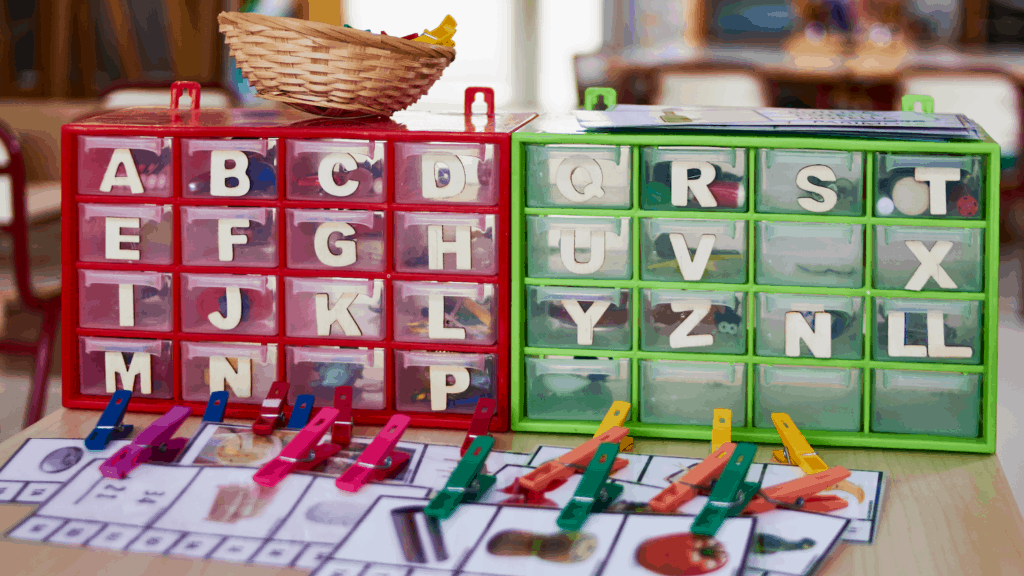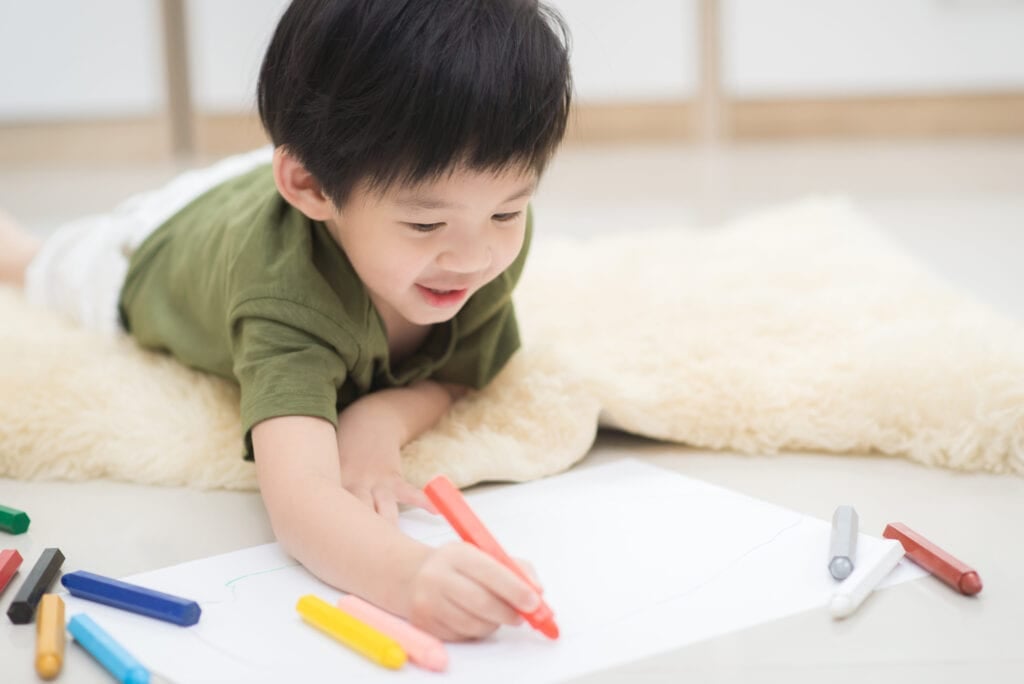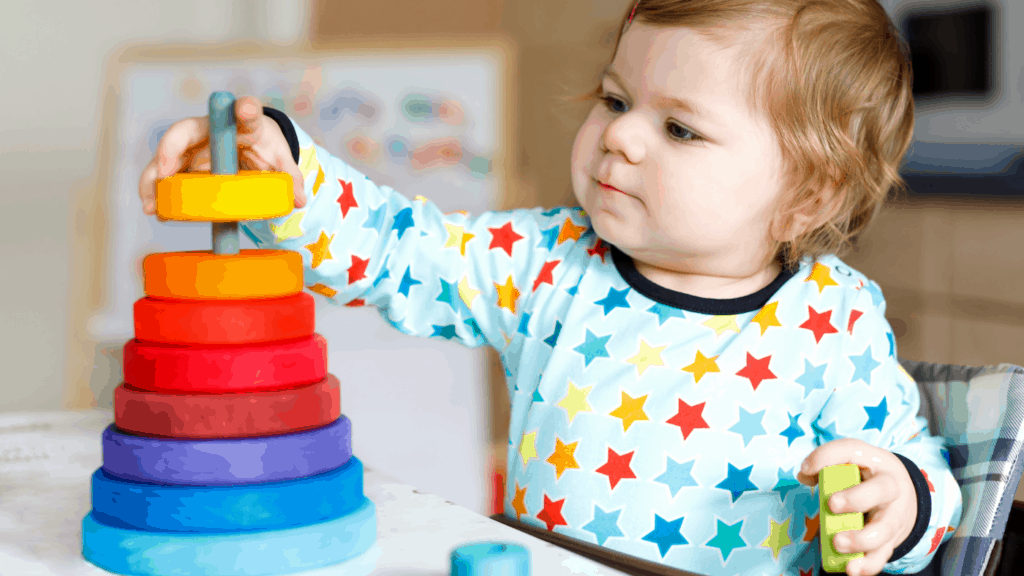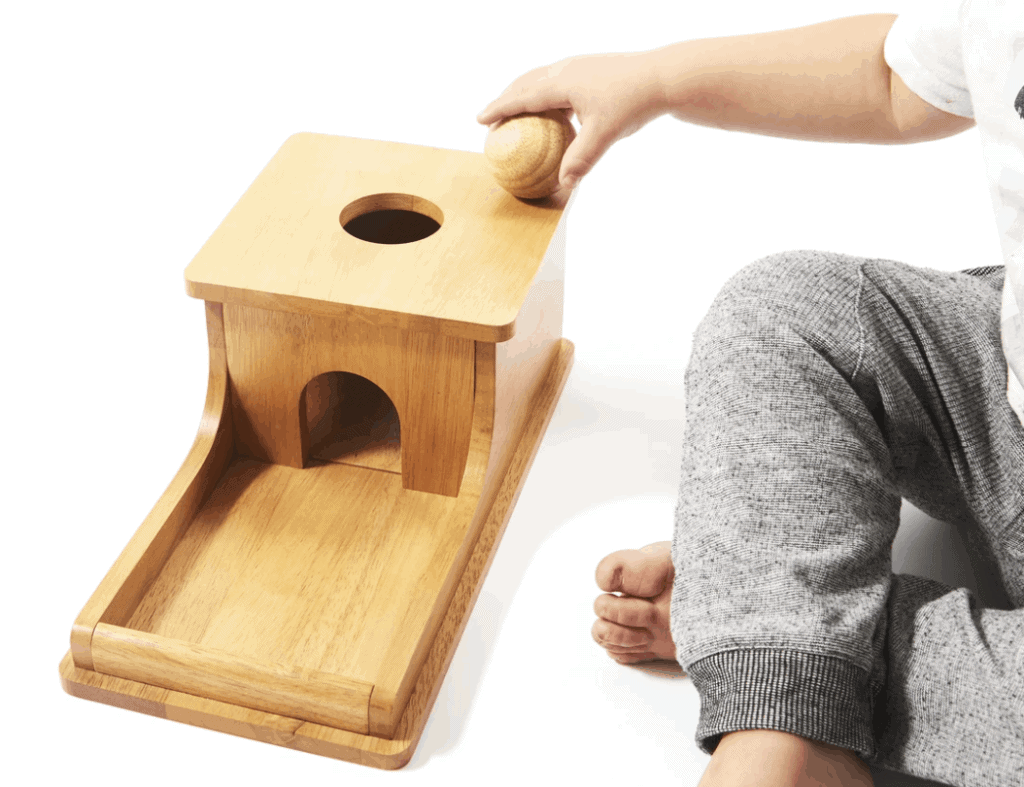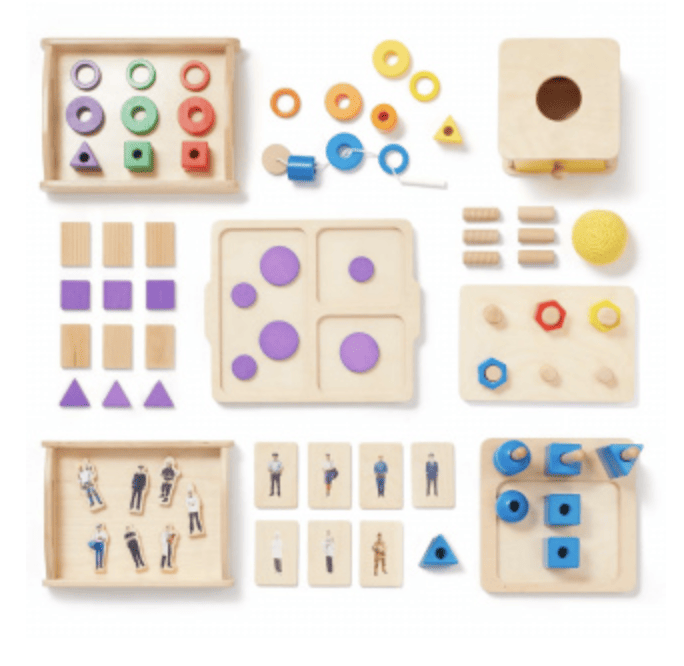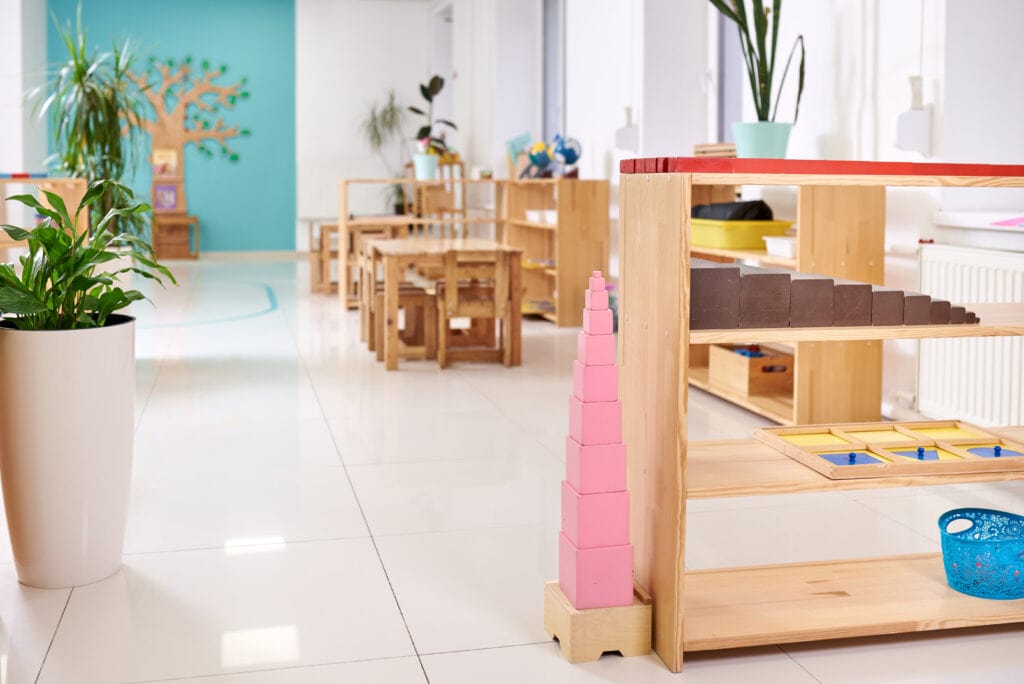10 of the best Montessori activities for 6 to 9 month olds include:
On This Page…
- 10 of the best Montessori activities for 6 to 9 month olds include:
- 1. Toy on a Suction Cup Base
- 2. Treasure Basket of Animals
- 3. Sensory Play
- 4. Musical Instruments
- 5. Spinning Drum
- 6. Cube in a Box
- 7. Bell Cylinder
- 8. Wooden Ring Stacker
- 9. Wooden Egg in a Cup
- 10. Placing Objects in a Box
- Next, check out some more great activities for:
1. Toy on a Suction Cup Base
A
You can offer this toy while the baby is in their Montessori high chair or once they can sit unsupported. As the baby reaches for the toy to bat it, they will grab the toy too. Toys of this type can support the following areas of development:
- Fine Motor Skills: Grasping and releasing the toy can help develop the muscles in the hands and fingers, which is essential to the development of fine motor skills.
- Hand-Eye Coordination: With this toy, the baby can visually track the toy’s movements. This aids in the development of hand-eye coordination.
- Sensory Development: The toy can be used to explore different textures, colors, and shapes, which can help to stimulate the baby’s sense of touch, sight, and hearing.
- Problem-Solving Skills: As the baby gets older, the toy can be used to encourage the baby to figure out how to detach the toy from the suction cup base. This can help to develop problem-solving skills.
The best part about this activity is that any item that you could attach to a suction cup can make a great DIY toy for this activity. There are also options available for purchase, such as this Melissa and Doug bead maze on a suction cup base.
Montessori for Today picks out furniture, educational tools, toys and lifestyle items that we think are the best and most exciting, based on independent research and careful consideration. On some occasions we earn revenue (at no additional cost to you) if you click the links and buy the products. But this doesn’t affect what we choose to highlight and we will never let it bias our coverage.
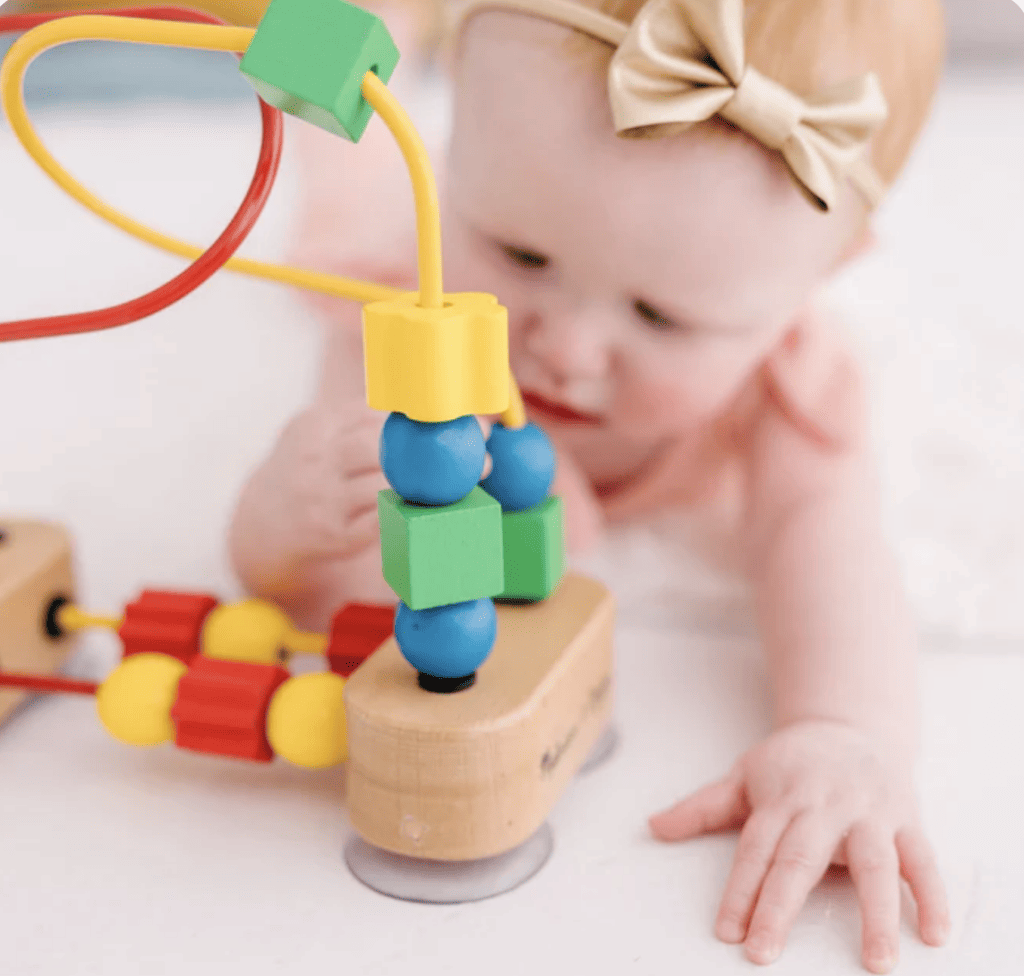
2. Treasure Basket of Animals
The
Initially, the animals expose a 6-month-old infant to different forms, as babies usually explore these items by picking them up and putting them in their mouths. Handling and manipulating small plastic animals can help to develop infants’ fine motor skills.

This type of treasure basket also aids with cognitive development. The different animals can be used to introduce babies to new concepts such as animal names, characteristics, and sounds, helping to develop their cognitive understanding of the world.
Additionally, this particular treasure basket can help with language development as it exposes babies to new languages. Caregivers can label the animals or make animal sounds as the baby plays with them. This treasure basket also promotes social interactions between caregivers and infants, and can model social behavior to an infant.
3. Sensory Play
Sensory play is a great activity that does not require any purchased
Fruits and vegetables have different textures, smells, and shapes which are perfect for babies to explore. This activity introduces infants to their environment and can double as a practical life activity.
Another fun sensory activity is cooked spaghetti noodles. To make this activity more interesting you can add food coloring to the water. For this sensory activity, all you need to do is cook some noodles, and then let your infant play with them (once they have cooled of course.) They will have so much fun exploring the texture, shape, and smell of the spaghetti.
4. Musical Instruments
6 to 9 months of age is the perfect time to introduce babies to musical instruments. For this activity place 3 or more infant-safe musical instruments in a basket and let the baby explore. You can use maracas, hand shakers, spoons, or any other baby-safe instrument you have at home.
It is important to remember that babies of this age will not be able to use the instrument how they are ‘supposed’ to, and that’s ok! The point of this activity is to expose them to new textures, sounds, and actions.
Music plays an important role in the

Playing with instruments, whether it be shaking a rattle, striking a drum, or listening to a song, can help babies understand the different properties of sound and develop their listening skills.
In addition to auditory development, introducing infants to musical instruments positively impacts their cognitive development. Children have a natural curiosity to understand the world around them. Playing with instruments can help them explore cause and effect, understand different properties of sound, and learn to associate certain sounds with certain instruments.
5. Spinning Drum
The spinning drum material consists of 6 rectangular wooden panes that make up a drum. The panes can be colorful or glittered, and one pane usually has a mirror, which makes it extremely engaging for babies. The drum contains a small marble, which means it makes a noise every time it is spun.
A spinning drum is an excellent tool for infants to engage with their environment and develop important skills. The spinning drum is a fun activity that gives infants a sense of purpose as babies reach out the touch the colorful pane, it spins, thus giving them a reason to reach for it. Additionally, the activity introduces the concept of cause and effect.

Playing with a spinning drum allows babies to practice using their hands in a new way by turning the drum. It also strengthens the muscles in their fingers and wrists as they work to maintain control of the drum as it spins.
The addition of the marble to the drum makes this activity a truly multi-sensory activity that helps babies with auditory development. It provides a way for infants to explore the different properties of sound and develop their listening skills. As they get older, infants will try to control the sound the drum makes.
Infants will begin to respond with their bodies to the sound the marble makes in the drum, which introduces them to rhythm and timing in music.
6. Cube in a Box
The cube in a box activity is a fun introduction to problem-solving for infants aged 6 to 9 months. The material consists of a wooden box that houses a solid wooden cube. The aim of the activity is for the baby to place the cube back in the box.
This activity is easy to make yourself. All you need is a box, which could be a tissue or napkin holder, or an even smaller-sized box if you prefer, and a wooden (or similar) cube which can be a craft cube. The cube must fit perfectly inside the box, with a little give so the baby can manipulate it easily.
The cube in a box activity is linked to Mathematics in the
Infants at this age are just beginning to develop the ability to grasp and manipulate objects with their hands. Playing with the cube allows them to practice using their hands in a new way by fitting the cube in the box, thus developing their fine motor skills.
As infants engage with the activity, they will experiment with different ways to fit the cube, which will help to build their logic and critical thinking skills.
For a similar activity, check out our full article about the Montessori object permanence box.
7. Bell Cylinder
The bell cylinder is a toy or material you may have introduced when your baby turned 3 months old. Infants between the ages of 6 and 9 months discover a whole new dynamic with the toy.
The bell cylinder is a wooden cylinder made with rods that allow you to see the bell within. The design of the toy makes it mobile, which is great for babies who are just starting to learn how to crawl.
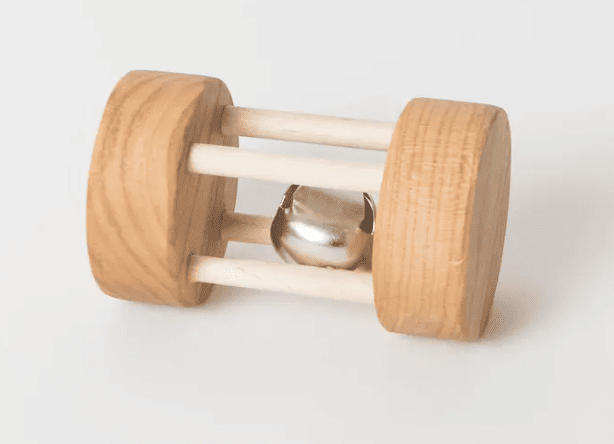
The bell cylinder can help with gross motor development. Infants at this age are just beginning to develop the ability to move their bodies and explore their environment. The bell cylinder provides an incentive for the child to crawl after it and chase it as it rolls away, helping to improve their crawling and coordination skills.
Another area of development that can be supported through the use of a bell cylinder is auditory development. The sound the bell makes as it rolls or shakes in the cylinder provides a way for infants to explore the different properties of sound and develop their listening skills.
8. Wooden Ring Stacker
Wooden rings on a stacker (a rod with a stable base) are a super simple and engaging activity with many benefits. This is a great activity that you can make yourself by purchasing crafting rings and using the wooden base of your kitchen paper towel holder.
This activity is great for fine motor skill development as infants grasp the wooden rings and manipulate them to put them on and off the wooden stacker. In the process of manipulating the rings, babies strengthen the muscles in their fingers and wrists as they work to maintain control of the rings as they stack them.
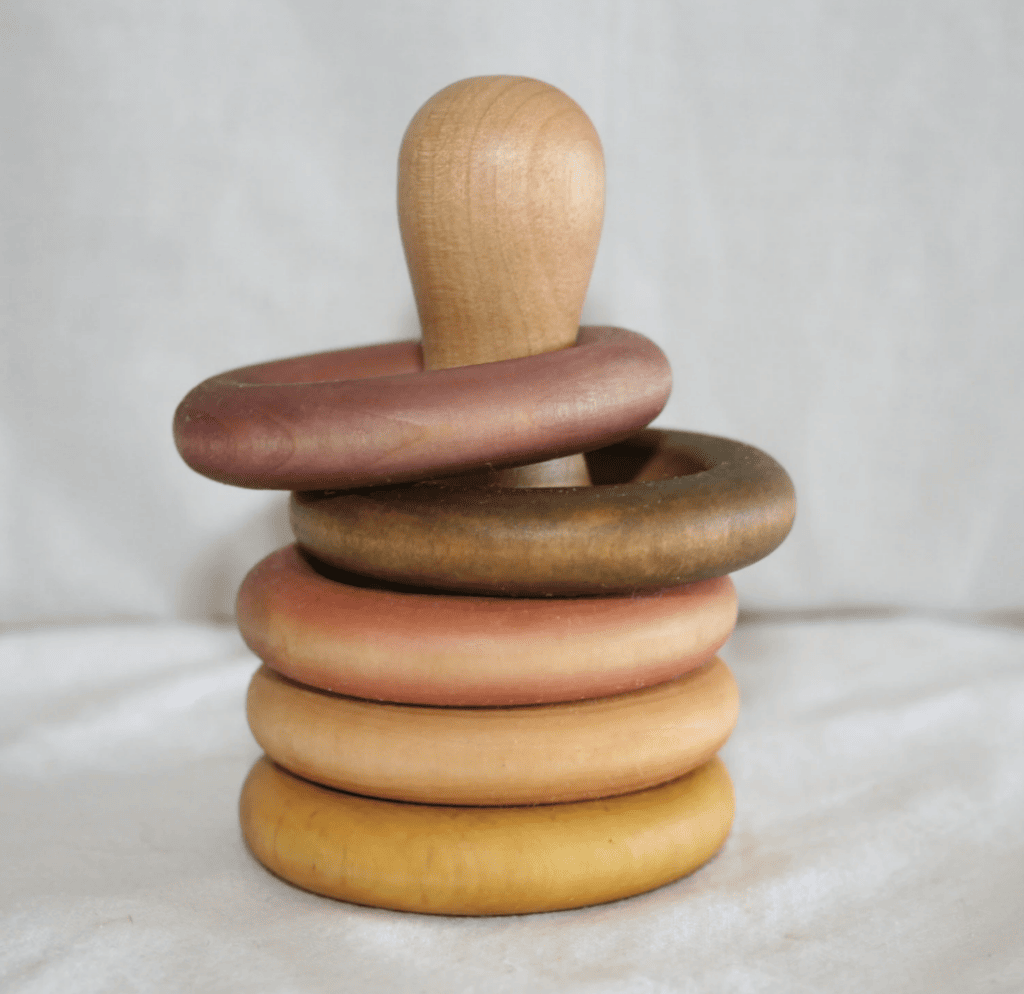
This sensorial activity also encourages problem-solving, as they have to figure out how to place the rings onto the stacker. This activity is a precursor to the stackers that contain rings of different sizes and colors.
9. Wooden Egg in a Cup
The wooden egg in a cup is an infant’s first introduction to puzzles. This material consists of a wooden egg that fits inside an egg cup. The aim is for the infant to remove the egg from the cup and put it back again.
When babies manipulate the egg to get it in and out of the cup, they are developing their fine motor skills. In addition, the wooden egg in a cup requires the child to figure out how to fit the egg in the cup correctly, allowing them to practice problem-solving skills in a fun and engaging way.
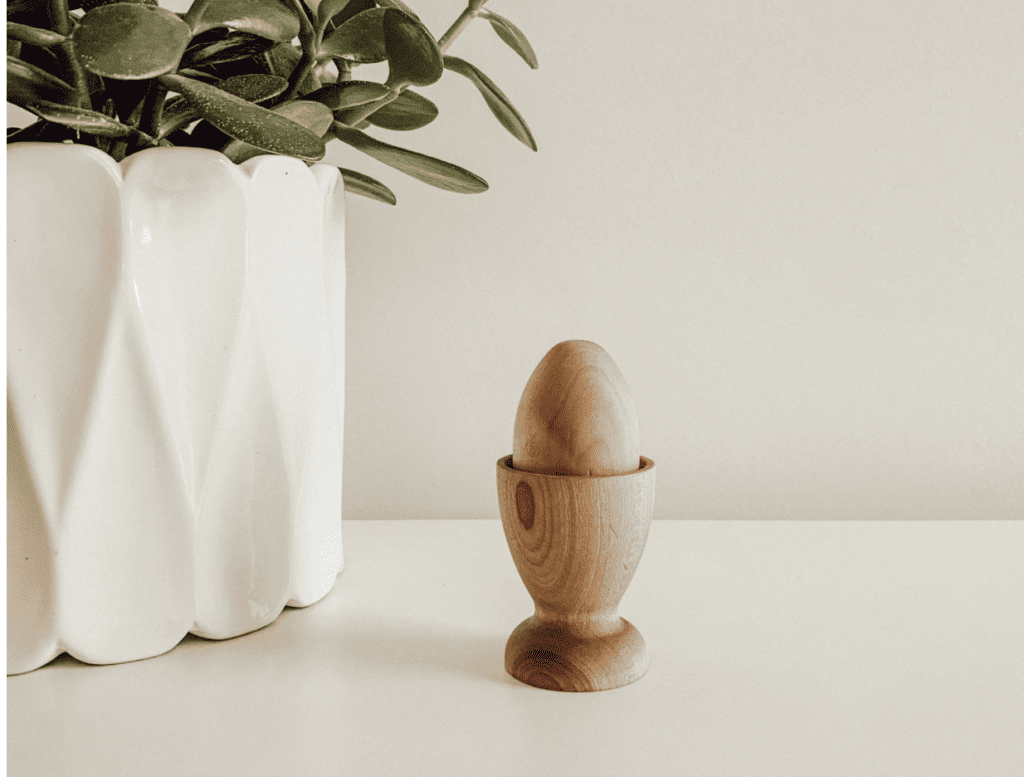
Check out our full article on the Montessori Egg Cup for more information.
10. Placing Objects in a Box
This activity is one your infant will love, and it’s easy to set up. All you need is a tissue box and baby-safe objects that will fit in it. The objects should all vary in texture if possible, to provide a multi-sensory experience.
You can use different types of paper for the activity, or fabrics. This activity helps to develop babies’ problem-solving skills as they work out how to place objects within the box. It is also great for fine motor skills development!


